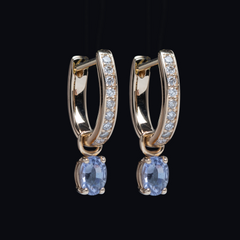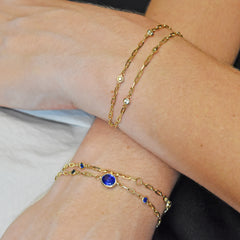Sapphire Prices By Color - Based on 2022 Market Value 1ct+
Shop our sapphires from our curated gemstone collection here


We've prepared a selection of 1 carat sapphires of various colors to show you real market prices and how they fluctuate based on color and saturation. We will cover blues, pinks, padparadscha, yellows, greens, teals and so much more!
If you are looking to purchase a sapphire or a bespoke sapphire engagement ring, send us an email at info@fineandflux.com or fill out the form at the bottom of the page and we will be happy to provide you with a free quote.
Note: all stones (unless indicated otherwise) used in this blog have the same quality of clarity, cut (excellent-very good), heat treated and similar carat weight, in order to really focus on the difference of price solely based on colors & they're different saturations. Based on 2022 market prices. To read about the basics of sapphires (identifying qualities, synthetics, hardness and more) click here.
Blue Sapphire Prices Per Carat
Blue sapphires—especially royal blue sapphires—are the most popular and highly valued among all sapphire colors. Prices typically start lower for lighter blue sapphires and increase as the color deepens into more vivid, royal blue tones. However, if the sapphire becomes too dark, its price often drops and may align with the cost of lighter stones.
Among all shades, cornflower blue sapphires are considered the most valuable, prized for their vibrant yet soft hue and exceptional brilliance.


As you can see, for roughly the same carat weight, a royal blue sapphire can be nearly three times the price of a lighter blue sapphire.
Here’s another beautiful example showcasing the difference in blue sapphire colors and pricing: two 6.5mm cushion-cut blue sapphires—the lighter stone is priced at $2,700, while the royal blue sapphire costs $7,000.
While royal blue is often the most sought-after shade, the lower price of lighter sapphires doesn’t reflect a lack of quality. In fact, light blue sapphires can offer exceptional brilliance, as they tend to reflect more light than darker stones—making them a stunning and vibrant option.
Padparadscha Sapphire Prices
Padparadscha sapphires are the rarest and most coveted among fancy colored sapphires. These exceptional gemstones are prized for their unique blend of pink and orange hues, often described as the color of a tropical sunset.
A simple way to identify a Padparadscha sapphire is by comparing it to other sapphires: when placed next to an orange sapphire, the Padparadscha will appear pink; when placed beside a pink sapphire, it will appear orange. This delicate color shift is part of what makes Padparadscha sapphires so rare and desirable.

Again the lighter shades drop in price. These prices do reflect similarly to royal blue prices
Pink Sapphire Prices: A Guide by Shade and Demand
Pink sapphires come in a range of shades—from vibrant hot pink, to medium pink, to soft pastel pinks. While hot pink sapphires (left) have a more intense saturation, their prices are often similar to medium pink sapphires (middle) due to relatively lower demand.
Light pink and pastel pink sapphires (right) are typically more affordable—often priced at nearly half the cost of hot pink varieties. Thanks to their soft hue and brilliance, they are an excellent alternative to pink diamonds, offering both beauty and value.

Fun fact, as soon as pink sapphires turn from a saturated pink to a red shade, they become rubies, which will then increase the price quite drastically.
Green Sapphire Colors and Prices: What to Know
Green sapphires come in a beautiful variety of shades—including yellowish-green, teal, forest green, and mint green. They’re a perfect example of how consumer demand can influence gemstone pricing.
In recent years, teal sapphires have seen a significant surge in popularity, driving prices sharply upward. Their unique blend of green and blue tones has made them a highly sought-after alternative to more traditional engagement gemstones.

Left we have a green sapphire, middle is teal and to the left a green sapphire with a tint of yellow.


Purple & Violet Sapphire Prices: Rare, Untreated Beauty
Though less common, purple and violet sapphires are a stunning and unique choice for those seeking a non-traditional gemstone.
While most sapphires undergo heat treatment to enhance color and clarity, purple sapphires are an exception. When exposed to heat, their color often shifts to blue or pink—causing the original purple hue to fade. For this reason, many lavender and violet sapphires are left untreated, preserving their natural beauty and making them especially desirable to collectors and those who value untreated gemstones.

White Sapphire Prices: An Affordable Diamond Alternative
White sapphires are a popular and affordable alternative to diamonds, especially among millennials seeking budget-friendly yet beautiful gemstones. Although white sapphires appear colorless, they can sometimes exhibit slight tints of yellow, blue, or even pink. For the best quality, it’s important to choose stones that are as colorless as possible.

As you can see for the white sapphire on the right, it weighs 1.13cts at 1500. In comparison to natural diamond the price would have been approximately 8-10X the price.
Yellow Sapphire Prices: Vibrant Yet Affordable
Yellow sapphires range from deeply saturated tones that can appear slightly orange to very light shades resembling yellow diamonds. While yellow sapphires are less commonly chosen compared to popular colors like royal blue, this rarity makes them a unique option for those seeking something different.
Because demand is lower, yellow sapphires tend to be more affordable—especially in larger carat weights—when compared to high-demand colors like royal blue sapphires.

How To Buy A Sapphire Engagement Ring?
 It's really quite easy and it only takes 5 seconds! All you need to do is send us an email with the color of sapphire you would like along with your budget. Once we've received that information, we will source 2-3 options of sapphires for you to choose from! We can also schedule a fast, casual conversation to see if we're a good fit! Payment plans are available upon request!
It's really quite easy and it only takes 5 seconds! All you need to do is send us an email with the color of sapphire you would like along with your budget. Once we've received that information, we will source 2-3 options of sapphires for you to choose from! We can also schedule a fast, casual conversation to see if we're a good fit! Payment plans are available upon request! You can view the quality of our custom work by clicking here.
Here are some of our sapphire jewelry and engagement rings:
.








